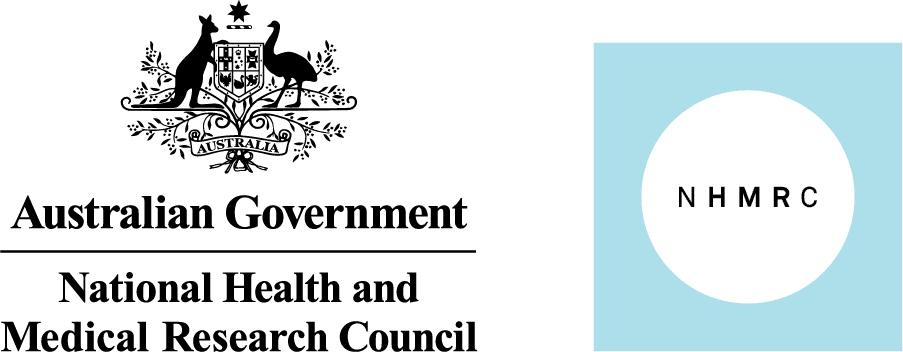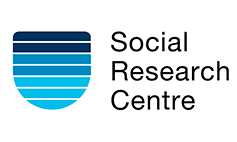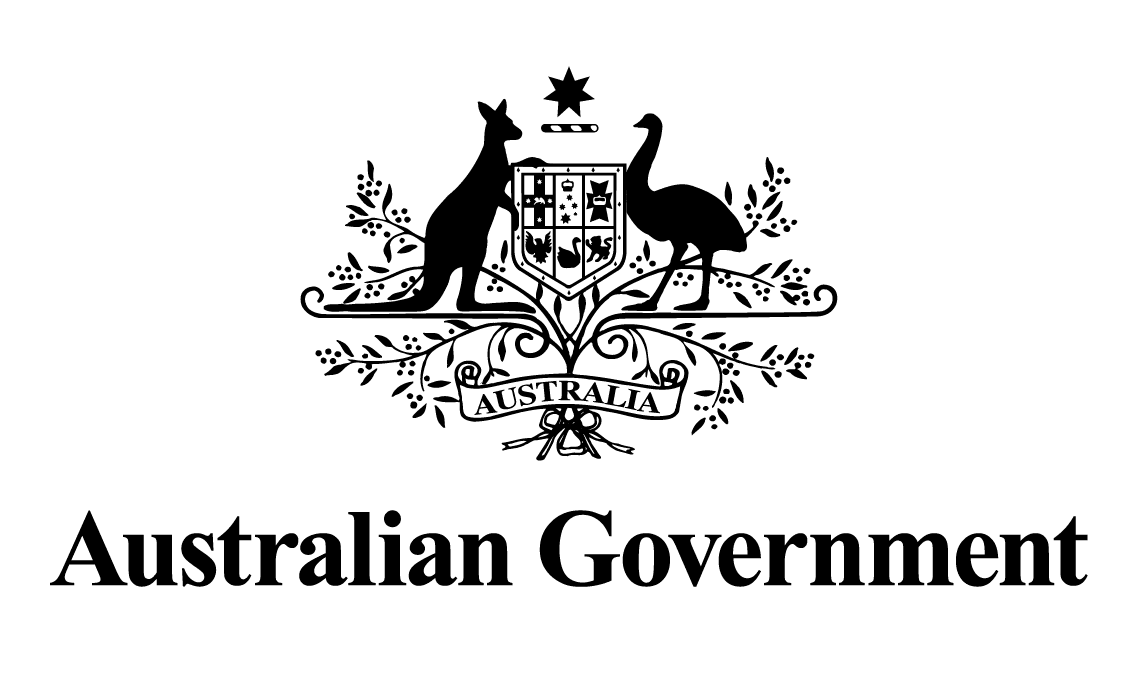This page provides a brief summary of the research design and methodology as well as a list of the general variables assessed during the ACMS interviews. Data from the ACMS will be made available to researchers with approved projects at the conclusion of the project following a short embargo period to allow for publication. Data is expected to be available for researchers with approved research topics in early 2026. Researchers wishing to collaborate prior to this may contact acms@qut.edu.au or Lead Investigator Professor Ben Mathews on b.mathews@qut.edu.au
The ACMS wass the first Australian prevalence study of child abuse and neglect conducted in Australia. Moreover, it is internationally significant given it is one of the most comprehensive prevalence studies ever conducted due to its inclusion of adult retrospective reports and the detailed nature of current physical and mental health which include clinical diagnoses and data required to calculate the associated burden of disease. The ACMS was funded by the National Health and Medical Research Council with some additional funding by selected partners. The ACMS received ethical clearance from the Queensland University of Technology Human Research Ethics Committee (ref 1900000477)
The contents of this website are solely the responsibility of the research team and do not reflect the views of the NHMRC.
Aims
The ACMS had three primary aims.
Specifically we aimed to examine:
- The prevalence of each type of child maltreatment (physical abuse, emotional abuse, sexual abuse, neglect, and exposure to domestic violence) and of multi-type maltreatment;
- The nature of maltreatment experiences (the child’s age and sex; the child’s relationship with the person who inflicted the maltreatment; frequency and severity of maltreatment; parental risk factors) and the health problems associated with maltreatment and multi-type maltreatment; and
- The burden of disease attributable to child maltreatment, and selected healthcare costs.

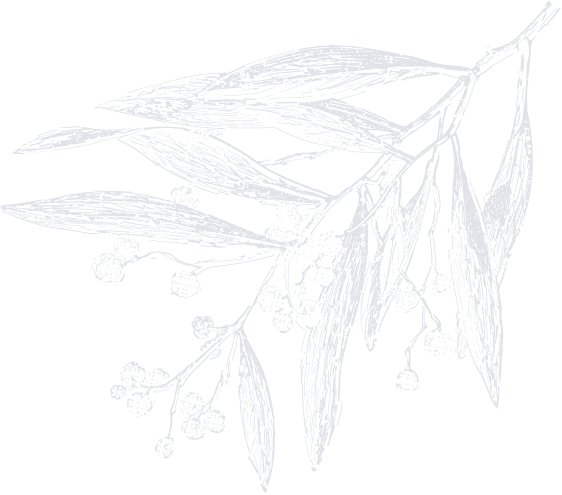
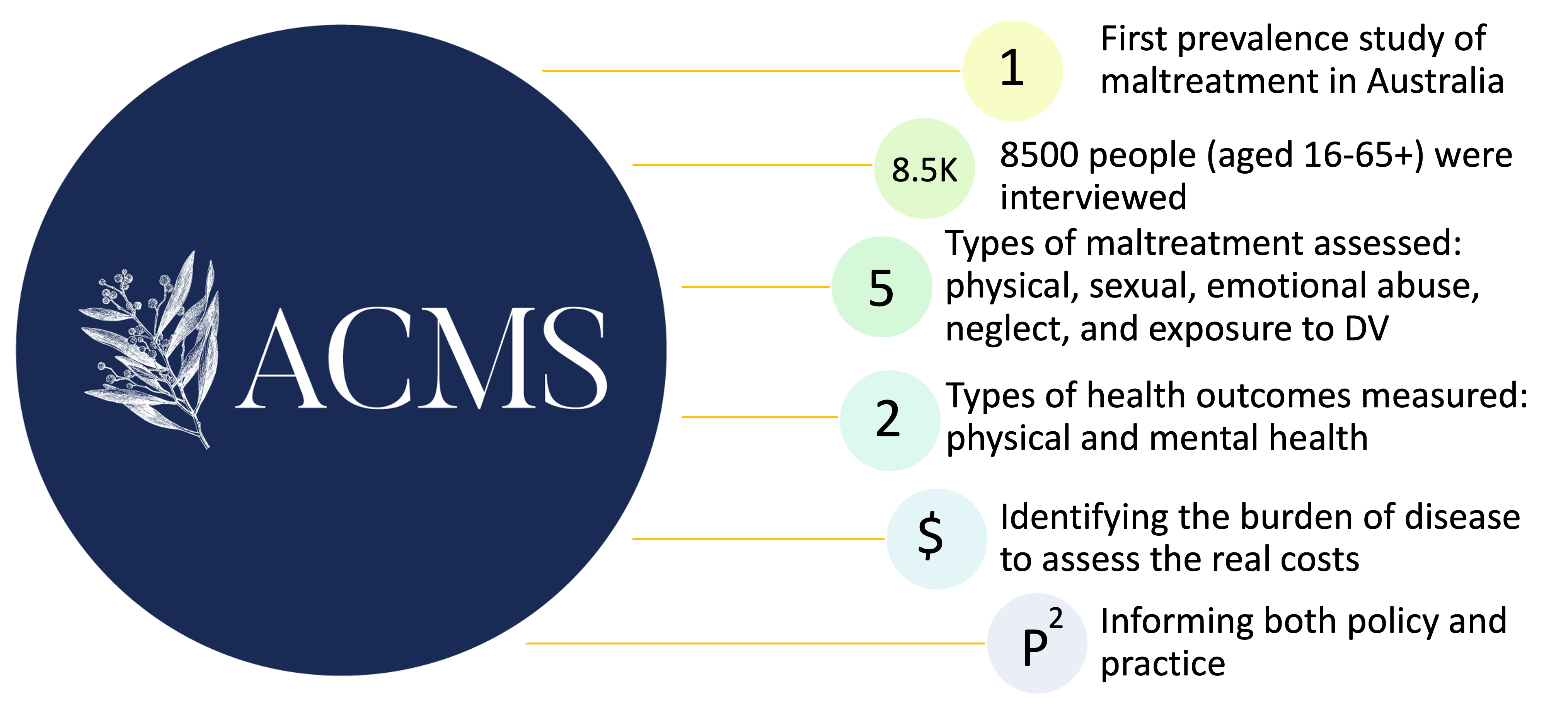


Participants
Details of the methodology of the ACMS have been previously published in a protocol paper and in the primary methodology paper .A total sample of 8503 was obtained. A recent meta-analysis by the chief investigators found the lifetime prevalence of non-penetrative sexual abuse for both sexes combined was estimated at 21.85%. For a prevalence survey, this prevalence could be detected with +/- 1 percent precision with a total sample of 6,549 adults.
In order to allow subsequent studies to track changes in prevalence, 5,000 participants in the 16-24 year age group was included. In addition, approximately 1,000 people were assessed in each of the following age cohorts: 25-34, 35-44, 45-54, 55-64, and 65 and over. Roughly equal genders were represented in each age cohort. As detailed in the methodology paper the sample was representative of the Australian population.
Participants were be eligible to participate if:
- They are in the relevant age sample at the time of contact
Participants wereexcluded from participation if:
- They cannot speak or understand English
- They are outside the age or gender sampling at the time of initial contact.
Design
and Methods
The ACMS used a cross-sectional retrospective survey design. Data was collected via random telephone sampling and Computer Assisted Telephone Interviewing (CATI) technology. Potential participants received an advance text message including a link to the study website prior to receiving personal invitations via phone. Following screening, participants provided verbal informed consent for participation in the current study and for their anonymous data to be used in related studies. They could then participate in the interview immediately or schedule an interview at their preferred time. All interviews were conducted by our research partner The Social Research Centre during 2020 (for the pilot) and 2021 (for primary data collection).
To assess lifetime childhood prevalence of maltreatment all participants (irrespective of age) answered retrospective questions about their childhood exposure to the five types of maltreatment (physical abuse, sexual abuse, emotional abuse, neglect, and exposure to domestic violence). In addition participants aged 16-17 years reported past year exposure to maltreatment in order to allow past year prevalence and past year incidence to be calculated. All participants were surveyed about their current physical and mental health status.
Sampling
Frame
Participants were contacted randomly via telephone using Random Digit Dial. Data indicated 93% of Australians own a mobile phone. An all-mobile sampling frame was be used. Numbers were selected via a Random Digit Dial. Potential participants were screened and invited to participate via telephone. Once the required sample of each age cohort is met no further participants in that age group were accepted.

Instruments
& variables assessed
A wide range of variables were assessed during the interviews. Only the primary variables are listed here. See more details in the methodology paper. For participants who are 16 or 17 years old, lifetime prevalence, past year prevalence and past year incidence were collected. For the primary outcome measure of child maltreatment, the study team employed a revised version of the Juvenile Victimisation Questionnaire (JVQ). The relevant items of the JVQ have been substantially revised through a rigorous testing process. These revisions have ensured the items map on to the most robust current conceptual models of the five types of maltreatment. This revision occurred in consultation with the investigator team, the JVQ’s original authors, an international panel of technical experts, and representative survivors of child abuse and neglect. The revised instrument was then subjected to two phases of cognitive testing and quantitative pilot testing to establish psychometrics. Details of this process have been published and copies of the items are available in the supplementary material of the methodology paper. If wish to use this revised ACMS version of the JVQ, please contact lead investigator Ben Mathews.
On the conclusion of the project and the embargo period the complete survey instrument (excluding copyrighted items) will be made available on this page and will be available via a creative commons license. This is expected in early 2026. For researchers (including research higher degree students and postdoctoral researchers) interested in collaboration at any time please contact our research team on acms@qut.edu.au. The final data set will be available to approved researchers wishing to conduct related studies following the conclusion of the project and a two year embargo period. Requests for data access will be open in 2026
Childhood related variables
| Construct | Instrument |
|---|---|
| Physical abuse | Juvenile Victimization Questionnaire (tailored) |
| Emotional abuse | Juvenile Victimization Questionnaire (tailored) |
| Sexual abuse (including internet victimization) | Juvenile Victimization Questionnaire (tailored) |
| Exposure to domestic violence | Juvenile Victimization Questionnaire (tailored) |
| Neglect | Juvenile Victimization Questionnaire (tailored) |
| Corporal punishment | Juvenile Victimization Questionnaire (tailored) |
| Peer bullying (including internet victimization) | Purpose built items |
| Sibling bullying | Purpose built items |
| Contextual factors related to the abuse including child age and sex, frequency, severity, and relationship with the person inflicting the abuse. | Juvenile Victimisation Questionnaire (tailored) |
| Adverse Childhood Experiences | Various items including many items included in the National Survey of Children’s Health . Exposure to significant health issues in childhood will also be assessed. |
| Perceived family financial pressure during childhood | Purpose built items |
Other variables
| Construct | Instrument |
|---|---|
| Major depressive disorder clinical criteria (Lifetime) | Mini-International Neuropsychiatric Interview (M.I.N.I.) |
| Alcohol use disorder clinical criteria (Current) | Mini-International Neuropsychiatric Interview (M.I.N.I.) |
| Generalized anxiety disorder clinical criteria (Current) | Mini-International Neuropsychiatric Interview (M.I.N.I.) |
| Post traumatic stress disorder clinical criteria (Current) | Mini-International Neuropsychiatric Interview (M.I.N.I.) |
| Suicidality (current and past ideation and attempts) | Suicidality questions from the National Adolescent Mental Health Surveys |
| Non-suicidal self harm | Suicidality questions from the National Adolescent Mental Health Surveys |
| Cardiac diagnosis (lifetime reported diagnosis, past year treatment and age of onset) | Adapted from the National Survey of Mental Health and Wellbeing |
| Adult use of corporal punishment (and perceived necessity of corporal punishment to raise children) attitudes towards corporal punishment) | Purpose built items |
| Diabetes or high sugar diagnosis (lifetime reported diagnosis, past year treatment and age of onset) | Adapted from the National Survey of Mental Health and Wellbeing |
| Tobacco use (current and past use) | Adapted from the National Survey of Mental Health and Wellbeing |
| Alcohol use (current and 12 month use, perceived problem use) | Purpose designed items |
| Marijuana use (frequency and dependence) | Purpose designed items (frequency) Severity of Dependence Scale (dependence) |
| Obesity | Body mass index |
| Health service utilisation (including hospitalisations, medical and mental health consultations from generalists, specialists, allied health and complementary therapists) ) | Adapted from the National Survey of Mental Health and Wellbeing and purposely designed |
| Intimate Partner Violence (Including psychological, sexual, physical abuse) | Composite Abuse Scale Short Form |
| Involvement in justice system including arrests, convictions and incarcerations | Purpose designed items |
| Demographics (range of demographic variables including age, ethnicity, country of birth, education, gender identification, sexual orientation ATSI status, financial stress, marital status, work status postcode) | Purpose designed items |
Timeline
The project was funded by the NHMRC for five years from 2019-2023 (App 1158750). Additional funding was provided by the Australian Government. The table below shows the primary tasks for each year. Of particular note, the primary data collection will occur in 2021. Results will be published on an ongoing basis.A range of primary outcomes have been published including a special ACMS edition in the Medical Journal of Australia and a layperson’s report. a Data will be banked and available for use by approved researchers in 2026 following a short embargo period.
| Year | Year | Primary Focus |
|---|---|---|
| One | 2019 | Project planning, instrument design, ethics |
| Two | 2020 | Cognitive testing and pilot analysis |
| Three | 2021 | Primary data collection |
| Four | 2022 | Data analysis and report writing |
| Five | 2023 | Publication of key findings and report (final year of funded study) |
| Six | 2024 | Ongoing knowledge transfer and publications |
| Seven | 2025 | Ongoing knowledge transfer and publications |
| Eight | 2026 | Data deposited and available for use by other researchers |

Data access
policy
While the formal project has concluded the team is continuing to publish key findings. The data will be embargoed for two years. Participant consent has been provided for de-identified data to be used by researchers for related projects. Data is expected to be accessible to the general research community in 2026. To access data researchers are asked to submit a request for data access form outlining their proposed project.
Requests for data access will be reviewed by the project team to ensure the proposal is suitably related to the current project as to be covered by the participants original consent. Selected researchers collaborating with the research team may have access to the anonymous data set prior to this data.
Our partners
The ACMS is proud to partner with the National Health and Medical Research Council, The Social Research Centre, and the Australian Government on this important project. For more information about our partners please click here.


